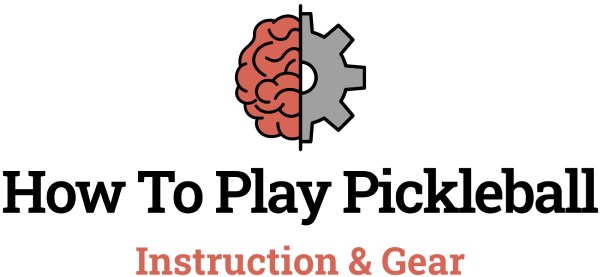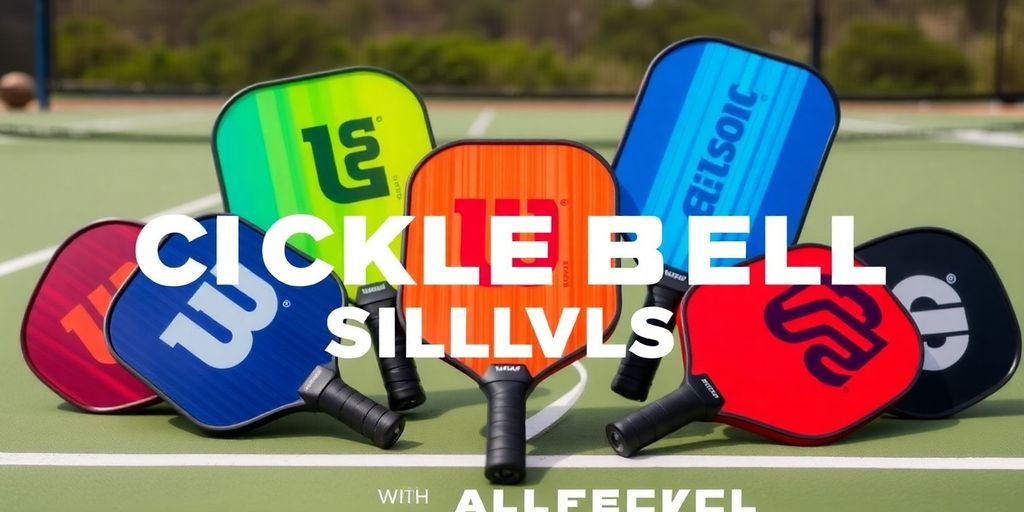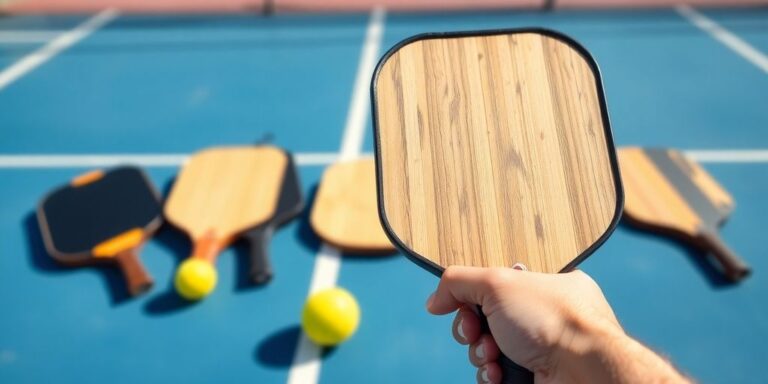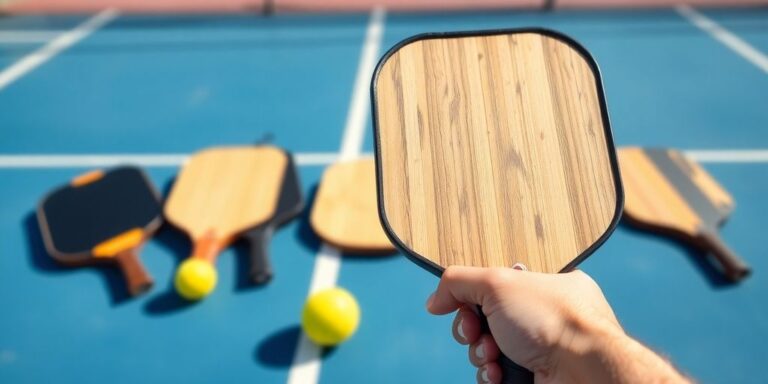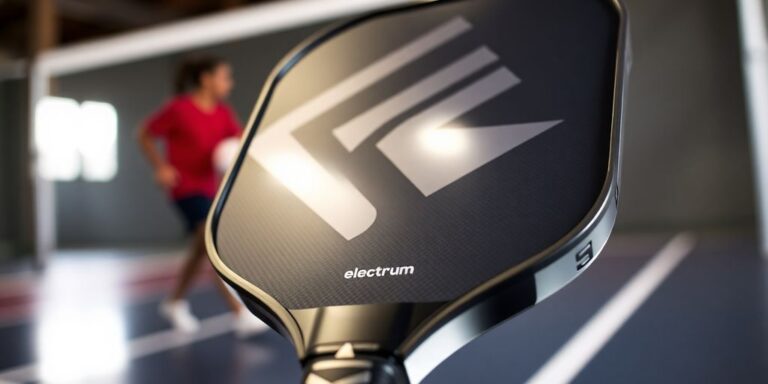Choosing the right paddle can be a bit overwhelming, especially with so many options on the market. Wilson pickleball paddles are known for their quality and performance, but how do you know which one is right for you? This guide will help you sift through the details to find the perfect paddle that matches your style and needs. Whether you’re just starting out or looking to upgrade, we’ve got you covered with essential tips and insights.
Key Takeaways
- Wilson pickleball paddles come in various styles to suit different player preferences.
- Understanding your playing style helps in selecting the right paddle features.
- Core and surface materials significantly affect paddle performance and feel.
- Weight and grip size are crucial for comfort and control during play.
- Testing paddles before buying can help ensure you find the right fit.
Understanding Wilson Pickleball Paddles

Overview of Wilson Pickleball Paddles
Wilson is a big name in sports, and their pickleball paddles are no exception. They’ve been around for a while, so they know what they’re doing. Wilson offers a range of paddles designed for different skill levels and playing styles. From beginner-friendly options to advanced paddles used by pros, there’s something for everyone. Wilson paddles are known for their quality construction and performance-enhancing features.
Key Features of Wilson Paddles
Wilson paddles come with a bunch of features that can really make a difference on the court. Here are a few things that stand out:
- Core Technology: Wilson uses different core materials, like polymer or Nomex, to give you the right balance of power and control. The core affects how the paddle feels and how the ball responds when you hit it.
- Surface Material: The surface material, often fiberglass or graphite, impacts spin and control. Some surfaces are designed for extra grip, letting you put more spin on the ball. If you are looking for tournament finesse, consider the surface material.
- Handle and Grip: Wilson pays attention to the handle and grip, making sure it’s comfortable and secure. A good grip can improve your control and prevent the paddle from slipping during intense play.
- Weight and Balance: The weight and balance of the paddle are important for maneuverability and swing speed. Wilson offers paddles in different weights, so you can find one that feels right for you.
Benefits of Choosing Wilson
Why go with Wilson? Well, there are a few good reasons:
- Reputation: Wilson has a solid reputation for making quality sports equipment. You know you’re getting a product that’s built to last.
- Variety: With a wide range of paddles, Wilson has something for every player. Whether you’re just starting out or you’re a seasoned pro, you can find a paddle that fits your needs.
- Performance: Wilson paddles are designed to enhance your performance on the court. From power to control to spin, these paddles can help you take your game to the next level.
Choosing a Wilson pickleball paddle can be a great investment in your game. With their focus on quality, innovation, and performance, Wilson paddles are a popular choice among players of all levels. If you are a beginner, make sure you consider lightweight pickleball paddles.
Identifying Your Playing Style
It’s easy to get lost in the technical details of pickleball paddles, but before you even start looking at core materials or surface textures, you need to figure out what kind of player you are. Are you all about power, smashing the ball past your opponents? Or do you prefer a more controlled game, placing your shots with precision? Understanding your style is the first step in finding a paddle that feels like an extension of your arm.
Power Players vs. Control Players
Okay, so which one are you? Power players are the ones at the net, looking to end the point quickly with a forceful drive. They often benefit from paddles that add extra punch to their shots. Control players, on the other hand, are masters of placement and dinking. They need a paddle that offers great feel and accuracy. Knowing where you fall on this spectrum will seriously narrow down your choices.
Think about your strengths. Do you win points by overpowering your opponents, or by outsmarting them with finesse? There’s no right or wrong answer, but your style dictates the kind of paddle you should be using. For example, if you’re a control player, you might want to look at paddles designed for enhancing spinspin paddles.
The Importance of Grip Size
Don’t underestimate the importance of grip size! A grip that’s too big or too small can throw off your entire game. It affects your control, comfort, and even your power. A too-small grip can lead to over-gripping, causing fatigue and potentially tennis elbow. A too-large grip can reduce your wrist mobility and make it harder to generate power.
Here’s a simple way to check your grip size:
- Hold the paddle in your dominant hand, using a forehand grip.
- You should be able to fit your index finger between your fingertips and the base of your thumb.
- If you can’t fit your finger, the grip is too small. If there’s too much space, it’s too big.
Most players will be fine with a standard handle, but there are reasons a player may choose a short or extended option. Handle length can affect maneuverability and power. For players with two-handed backhands, an extended handle might be preferable.
Choosing the Right Weight
Paddle weight is another key factor. Lighter paddles are easier to maneuver and can improve your reaction time at the net. Heavier paddles offer more power and stability, but they can also lead to fatigue over long matches. Finding the right balance is crucial.
It’s all about personal preference. Some players like the feel of a heavier paddle, while others prefer something lighter and more nimble. There’s no magic number, so experiment with different weights until you find what feels best for you. Also, consider your position on the court. The right side playerright side player might prefer a lighter paddle for quick reactions.
Ultimately, the best way to figure out your playing style is to get out on the court and play! Pay attention to your strengths and weaknesses, and don’t be afraid to experiment with different paddles until you find the perfect fit.
Core Materials and Their Impact
Types of Core Materials
Okay, so when you’re looking at Wilson pickleball paddles, you might not immediately think about what’s inside the paddle. But trust me, the core material makes a huge difference. It’s like the engine of a car – it really drives the performance. The most common materials you’ll find are polymer, Nomex, and sometimes even wood or aluminum in cheaper models. Each material has its own distinct feel and will affect how the paddle plays.
- Polymer: This is probably the most popular. It’s a type of plastic that gives you a good balance of power and control. It’s also known for being quieter than other options.
- Nomex: This stuff is super strong and lightweight. It’s actually used in things like military uniforms and airplane floors! Paddles with Nomex cores tend to give you more power, but they can also be louder.
- Wood/Aluminum: You’ll usually find these in less expensive paddles. They might be okay for beginners, but they don’t offer the same level of performance as polymer or Nomex.
How Core Affects Performance
The core material isn’t just some random filler; it seriously impacts how the paddle performs. Think about it: the core is what absorbs the impact of the ball and transfers energy back into your shot. A softer core, like polymer, will give you more control and feel, while a harder core, like Nomex, will give you more power. Core thickness also matters. Core thickness in pickleball paddles refers to the distance between the inside edges. Thicker cores generally provide more cushioning and reduce vibration, while thinner cores can offer a more responsive feel.
Choosing the Right Core for You
So, how do you pick the right core? Well, it really depends on your playing style. Are you a power player who likes to smash the ball? Then you might want to go for a paddle with a Nomex core. Do you prefer a more controlled game with lots of dinks and drops? Then a polymer core might be a better fit. It’s also worth considering the thickness of the core. Thicker cores can provide more cushioning and reduce vibration, which can be helpful if you have joint problems. Ultimately, the best way to choose is to try out a few different paddles and see what feels best to you. Consider foam and polymer differences to make an informed decision.
Don’t be afraid to ask other players what they use and why. Most pickleball players are happy to share their knowledge and let you try out their paddles. It’s a great way to get a feel for different core materials and find what works best for your game.
Surface Materials and Paddle Performance
Different Surface Options
Okay, so when we talk about the surface of a pickleball paddle, we’re really talking about what the paddle face is made of. This material is what actually comes into contact with the ball, and it has a HUGE impact on how the paddle performs. You’ll typically see paddles with surfaces made from graphite, carbon fiber, or fiberglass. Each one has its own feel and characteristics.
- Graphite: Known for being lightweight and offering great control. It’s a popular choice for players who like to finesse their shots.
- Carbon Fiber: Similar to graphite but often a bit stiffer, providing a little more power and pop. Carbon fiber surfaces are also known for their durability.
- Fiberglass: This material tends to be more forgiving and offers a softer feel. Fiberglass paddles can be great for beginners or players who want a comfortable feel and good ball control.
Impact of Surface on Spin and Control
The surface material plays a big role in how much spin you can generate and how well you can control the ball. A rougher surface will generally allow you to impart more spin on the ball, while a smoother surface might offer more predictability and control. For example, carbon fiber paddles often have textured surfaces that really grip the ball, letting you add some serious spin to your serves and dinks. Fiberglass, on the other hand, might not offer as much spin potential but can give you a better feel for the ball, helping with your accuracy and placement. The ability to generate speed and spin during play is key.
Choosing the Right Surface Material
Choosing the right surface material really comes down to your playing style and what you value most in a paddle. Are you a power player who likes to hit hard and generate a lot of spin? Then a carbon fiber surface might be a good fit. Do you prefer a more controlled game with precise shots? Graphite or fiberglass could be better options. It’s also worth considering the texture of the surface. Some paddles have a smooth finish, while others have a textured or gritty surface to enhance spin. Experimenting with different surfaces is the best way to find what works best for you. Consider paddles designed for optimal performance.
Ultimately, the best surface material is the one that feels most comfortable and allows you to play your best game. Don’t be afraid to try out different options and see what gives you the edge on the court.
Weight Considerations for Optimal Play

Lightweight vs. Heavy Paddles
When it comes to choosing a Wilson pickleball paddle, the weight category can really change your game feel. Lighter paddles (around 7.0 to 7.8 ounces) boost your quick reaction time and allow for fast maneuvering at the net. On the other hand, heavier paddles (above 7.8 ounces) pack extra power, which can help with strong serves and deep returns. Here are a few points to consider:
- Lighter paddles reduce the strain on your arm during long matches.
- Heavier paddles can offer extra power but might slow down quick exchanges.
- The right weight depends on your style and personal comfort quick guide.
Finding the Right Balance
It’s not just about the overall weight—the balance of the paddle matters too. A well-balanced paddle, where the weight isn’t overly centered at the head, can make a big difference in your control and swing speed. Consider these steps when checking out a paddle’s balance:
- Hold the paddle to see if the weight feels evenly distributed.
- Try out swings to gauge how it handles both forehand and backhand shots.
- Notice if any part of the paddle feels too heavy, which could tire your wrist or elbow.
A small extra ounce in the wrong spot can feel much heavier. For many players, the paddle’s weight directly influences their comfort and performance.
How Weight Affects Your Game
The weight of your paddle influences both your speed and your power. Faster hand movements can lead to quicker reactions and better defense at the net, while a heavier paddle might help drive the ball deeper into your opponent’s court. Below is a quick table breaking down typical weight categories and their impact:
| Weight Category | Approximate Weight (oz) | Impact on Play |
|---|---|---|
| Featherweight | Under 7.0 | Extremely nimble, ideal for quick dinks |
| Lightweight | 7.0 – 7.8 | Great mix of speed and control |
| Heavyweight | Over 7.8 | Boosts power but may reduce maneuverability |
Keep in mind that your personal strength and playing style are key. Try a few different paddles if you can. This way, you can see how weight distribution affects your game dynamics and what suit you best skill ratings.
Trying out a few models in person gives you a real sense of how the balance and weight work together on the court. It’s a straightforward way to learn what feels most natural for your play.
Testing and Trying Out Paddles
Importance of Testing Before Buying
Okay, so you’ve read all about the different Wilson pickleball paddles, the materials, the weights, and you think you know what you want. But here’s the thing: reading about it is one thing, actually feeling it is another. Testing a paddle before you buy it is super important. It’s like buying shoes online versus trying them on in a store. You might think you know your size, but you really need to walk around in them to be sure. Same with paddles. What feels good in someone else’s hand might feel terrible in yours. Everyone has different preferences, different swing styles, and different levels of strength. Don’t just rely on reviews or what your friend uses. Get that paddle in your hand and play.
How to Test Paddles Effectively
So, how do you actually test a paddle? Here’s a few things I like to do:
- Warm-up: Don’t just jump right into a game. Warm up with the paddle, hitting some dinks, volleys, and groundstrokes. Get a feel for how it responds to different shots.
- Play a Game: A real game situation is the best test. You’ll see how the paddle performs under pressure, how it handles different speeds, and how it feels during longer rallies.
- Focus on Feel: Pay attention to how the paddle feels in your hand. Is it comfortable? Is it too heavy or too light? Does it vibrate too much? Does it give you the control you need?
- Try Different Shots: Don’t just stick to your favorite shots. Try different types of serves, different spins, and different angles. See how the paddle responds to your full range of play. Understanding how to play pickleball is key to testing effectively.
Utilizing Demo Programs
Many retailers and manufacturers offer demo programs, and these are a goldmine. Basically, you pay a small fee (sometimes it’s even free!), and they send you a paddle to try for a week or two. This is way better than just hitting a few balls in a store. You get to use it in real game situations, on your own court, with your regular playing partners. Demo programs are awesome because:
- Extended Use: You get more than just a few swings; you get days or weeks to really get to know the paddle.
- Variety: You can often demo multiple paddles at once, allowing you to compare them side-by-side.
- Risk-Free: If you don’t like the paddle, you just send it back. No commitment!
I cannot stress enough how important it is to try before you buy. I’ve seen so many people buy a paddle based on hype, only to be disappointed when it doesn’t live up to their expectations. Save yourself the money and the frustration – demo, demo, demo! Consider checking out the best pickleball paddles before you demo to narrow down your choices.
Maintaining Your Wilson Pickleball Paddle
Care Tips for Longevity
Okay, so you’ve got yourself a sweet Wilson pickleball paddle. Now, you want to keep it in tip-top shape, right? Here’s the deal: treat it well, and it’ll treat you well on the court. Think of it like your car – a little maintenance goes a long way.
- Clean it regularly: After each playing session, wipe down your paddle with a damp cloth. This gets rid of sweat, dirt, and any other grime that can build up and affect the grip and surface. You can use a mild soap if needed, but make sure to rinse it off completely and dry it.
- Store it properly: Don’t just toss your paddle in the trunk of your car or leave it baking in the sun. Extreme temperatures can mess with the paddle’s materials. Store it in a cool, dry place, preferably in a paddle cover.
- Protect the edges: The edges are the most vulnerable part of your paddle. Consider using edge guard tape to protect against scrapes and dings. It’s cheap and easy to apply, and it can save your paddle from serious damage.
I remember this one time, I left my paddle in the car on a super hot day. When I went to play the next day, the grip was all sticky and the paddle felt weird. Lesson learned: always store your paddle properly!
When to Replace Your Paddle
So, how do you know when it’s time to say goodbye to your trusty Wilson paddle? Well, it’s not always obvious, but here are a few signs to look out for:
- Dead spots: If you notice that the ball isn’t bouncing off the paddle with the same pop it used to, you might have developed dead spots. These are areas on the paddle face where the core material has broken down.
- Cracks or delamination: Obvious cracks or separation of the paddle’s layers (delamination) are clear signs that it’s time for a new paddle. Continuing to use a damaged paddle can lead to further damage and affect your game.
- Performance decline: If you’re consistently hitting shots long or wide, and you haven’t changed your technique, it could be the paddle. Over time, the materials in the paddle can lose their elasticity and responsiveness.
Signs of Wear and Tear
Okay, let’s talk about what to look for when inspecting your paddle. It’s not always about catastrophic failures; sometimes, it’s the little things that add up. Regular checks can help you catch problems early and extend the life of your paddle. Remember to enhance your pickleball serve by keeping your equipment in top condition.
Here’s a quick checklist:
- Grip Condition: Is the grip worn, torn, or slippery? A worn grip can affect your control and lead to blisters. Replacing the grip is a cheap and easy way to improve your paddle’s feel. If you are a sweaty pickleball player, consider an overgrip.
- Edge Guard: Is the edge guard peeling or damaged? A damaged edge guard exposes the core of the paddle to impacts, which can lead to cracks and delamination.
- Surface Scratches: Minor scratches are normal, but deep gouges can affect the paddle’s performance. Check for any areas where the surface material is wearing thin. Remember that even small weight considerations for optimal play can make a big difference.
| Area | Check For | Action |
|---|---|---|
| Grip | Wear, tears, slipperiness | Replace grip or add overgrip |
| Edge Guard | Peeling, damage | Replace edge guard tape |
| Paddle Face | Cracks, delamination, dead spots, gouges | Consider replacing the paddle |
By paying attention to these signs of wear and tear, you can keep your Wilson pickleball paddle in good condition and enjoy many more games to come. And remember, a well-maintained paddle is a happy paddle!
Taking care of your Wilson pickleball paddle is important for keeping it in great shape. Regularly clean it with a damp cloth to remove dirt and sweat. Store it in a cool, dry place to avoid damage. If you want more tips on how to maintain your paddle, visit our website for helpful advice!
Wrapping It Up
Choosing the right Wilson pickleball paddle can feel overwhelming, but it doesn’t have to be. Remember, it’s all about finding what works best for you. Think about your playing style, skill level, and what feels comfortable in your hand. Don’t hesitate to try out different paddles, and maybe even ask friends for their recommendations. The right paddle can really make a difference in your game. So, take your time, do a little research, and soon enough, you’ll be ready to hit the courts with confidence. Happy playing!
Frequently Asked Questions
How do I choose the right pickleball paddle?
The best way to find a paddle is to try different ones! Ask friends if you can use their paddles or check out a demo program. Try out various weights and grip sizes to see what feels best for you.
What should I look for in my first paddle?
When buying your first paddle, consider a mid-weight option. This will help you balance power and control as you learn the game.
What is the difference between light and heavy paddles?
Light paddles are easier to handle and can help with quick movements, while heavy paddles can provide more power but may tire your arm faster.
How do I know what grip size I need?
Grip size is important for comfort and control. You can measure your grip by holding a paddle and checking if you can fit your index finger between your fingers and palm.
How often should I replace my paddle?
You should replace your paddle if you notice signs of wear, like cracks or a loss of performance. It’s good to check your paddle regularly to make sure it’s still in good shape.
What materials should I consider when choosing a paddle?
Paddles can have different cores and surfaces. Common materials include polymer, Nomex, and aluminum for cores, and fiberglass or carbon fiber for surfaces. Each affects how the paddle performs.
